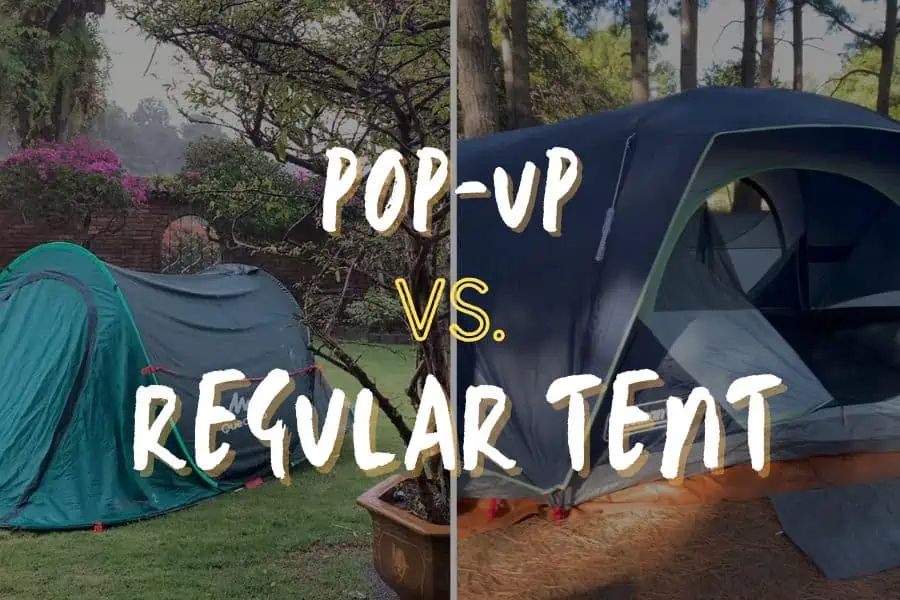Choosing a tent is not an easy job, especially since the market is swarmed with so many different models.
The first step to picking the right tent for you is to decide between the types of tents: pop-up or regular.
But which one is better? Well, that’s not something I can answer in one sentence.
So, let’s dive into the details of each to see which might be better for you.
Differences Between Pop Up Tents & Regular Tents
Pop Up Tents
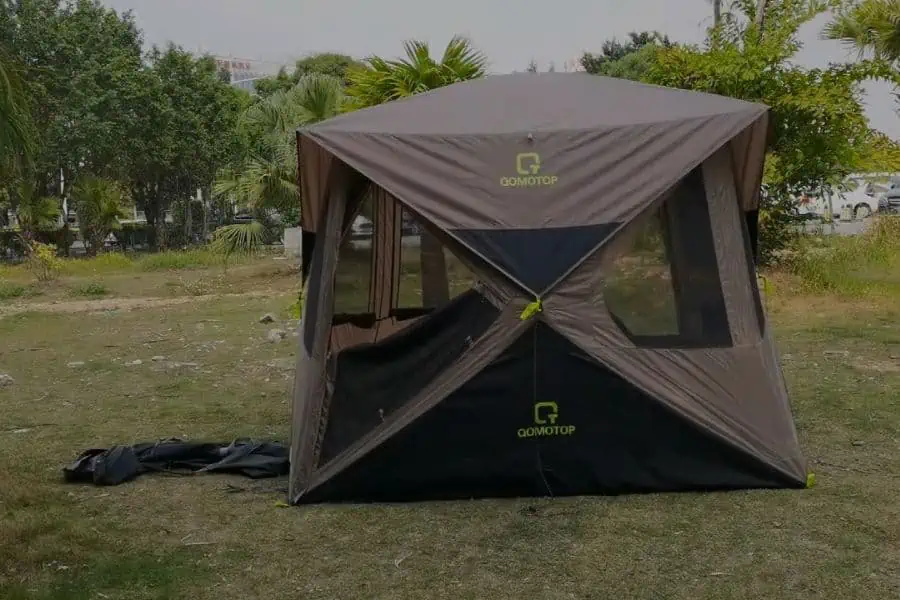
First things first, what is a pop-up tent?
A pop-up tent is any type of tent that literally pops into its shape as soon as you take it out from its carry bag.
It can do this because all the poles are already pre-attached to the tent. So, there’s no need for you to study the manual before assembling the whole construction.
This type of tent is designed to make tent pitching as simple and quick as possible. And as far as that goes, I think pop-up tents have made camping an easier activity, especially for first-timers.
Types Of Pop Up Tents
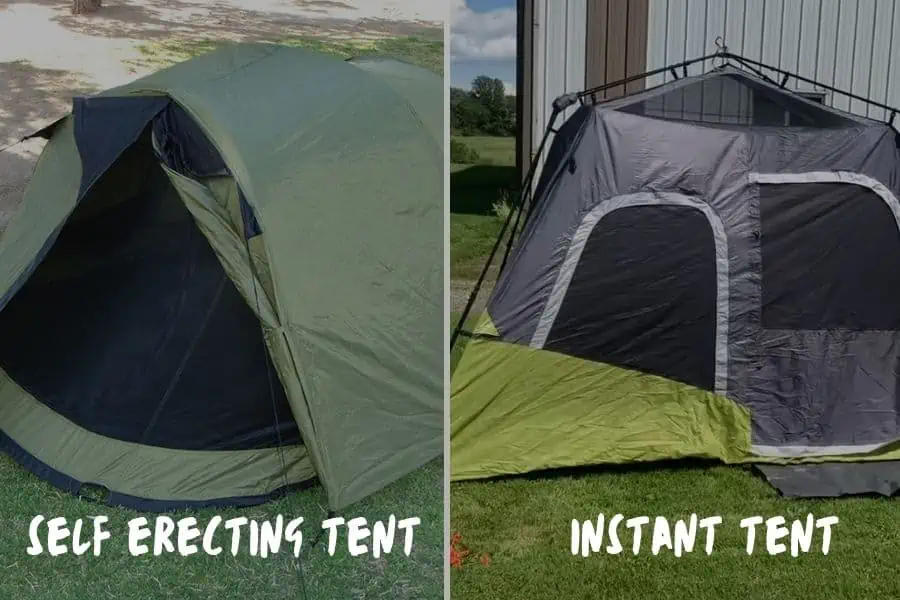
There are several different kinds of pop-up tents, which all offer something different to their users.
Before we get into details about whether you think a pop-up tent would be best for you, take a look at each kind and how they differ.
Instant Tents
The terms ‘pop-up’ and ‘instant’ have both been used to define tents that can be set up in less than a minute.
But while they’re often used interchangeably, it’s important to know they actually aren’t the same thing.
An instant tent is a type of pop-up tent that has all the poles pre-attached as a single frame. But unlike standard pop-up tents, it still needs a bit of work from you.
To set it up, you need to unfold the tent onto the ground, then grab a central hub and pull it upwards, which should expand the frame into its full shape.
As you can see, it doesn’t require very much effort to set up an instant tent.
While these instant tents can still be set up in under 60 seconds, I don’t consider them to be really instant if you have to unpack and stretch them before they expand.
It’s also worth noting that instant tents aren’t too common. Many big outdoor brands don’t have them in their product lines–and those that do typically market them for larger, family tents.
Self Erecting Tents
Most pop-up tents on the market are self-erecting, unlike instant tents that require something from you to be fully set up.
They also have all the poles connected into a single frame, but these poles are spring-loaded when the tent is packed down.
With these tents, the carry bag is the only thing keeping the springs compressed.
As soon as you take the tent out and untie it, the springs will push the poles into their designated positions, creating a fully set up tent.
Self-erecting tents are way more popular than instant tents, so getting your hands on one might be much easier.
Advantages Of Pop Up Tents
What’s so great about pop-up tents, anyway? Well, many things actually. In this section, let’s elaborate on each advantage individually.
Speed & Ease Of Setup
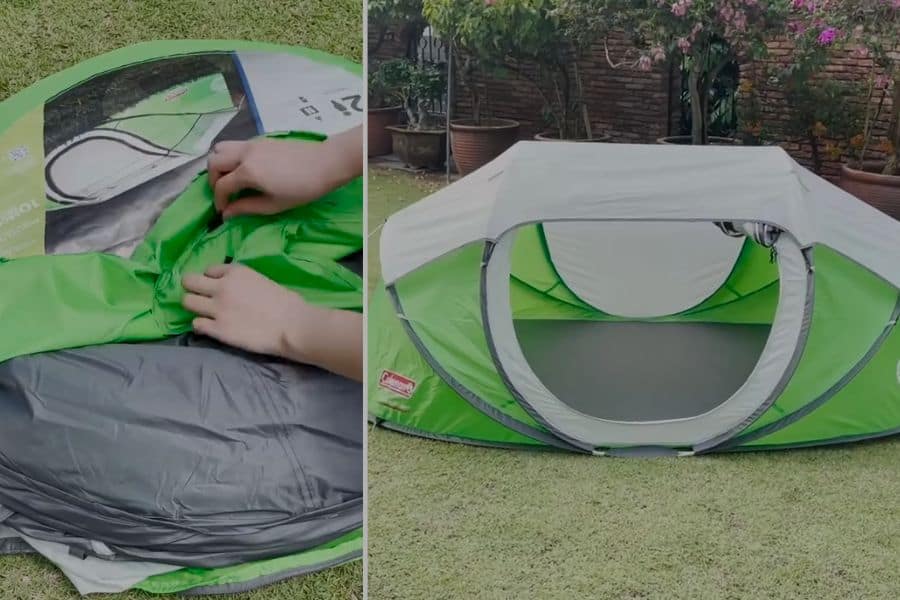
Let’s be real, who likes spending time pitching a tent? Even if you’re an experienced camper, I’m sure you’d rather use that time to do other things that are more fun.
Well, the main advantage of pop-up tents lies in their speed and ease of pitching.
After they are unpacked, self-erecting tents take no more than a few seconds to expand into their shape. No other tent can compete with this timing.
Instant tents are the same way. Even though it takes more steps to complete, they can still be set up within one or two minutes.
Plus, there’s no need to read and re-read the confusing manual with either of the two. Since the poles are pre-attached to the tent, everything is assembled and just needs to be expanded.
Plus, with these tents, taking them down is pretty much as quick and simple as pitching.
Portability & Compactness
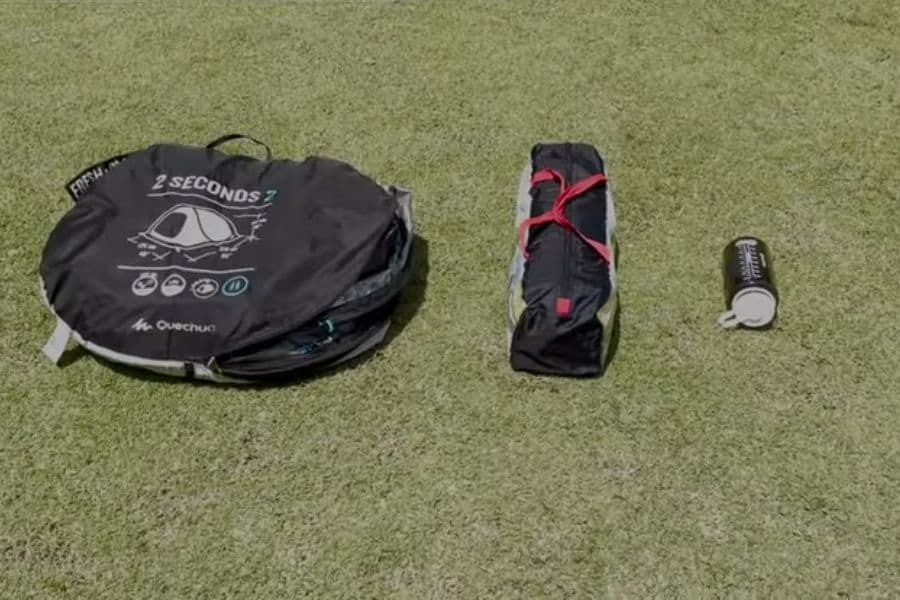
A pop-up tent can’t compare to backpacking tents when it comes to portability and compactness, but they are pretty convenient for travel.
This is especially the case with self-erecting tents, which typically pack down into a flat, round-shaped carry bag.
I personally love the way these tents pack down. If you’re car camping, the flat bag will take up very little space in your trunk–you won’t even notice it’s there.
Versatility For Various Occasions
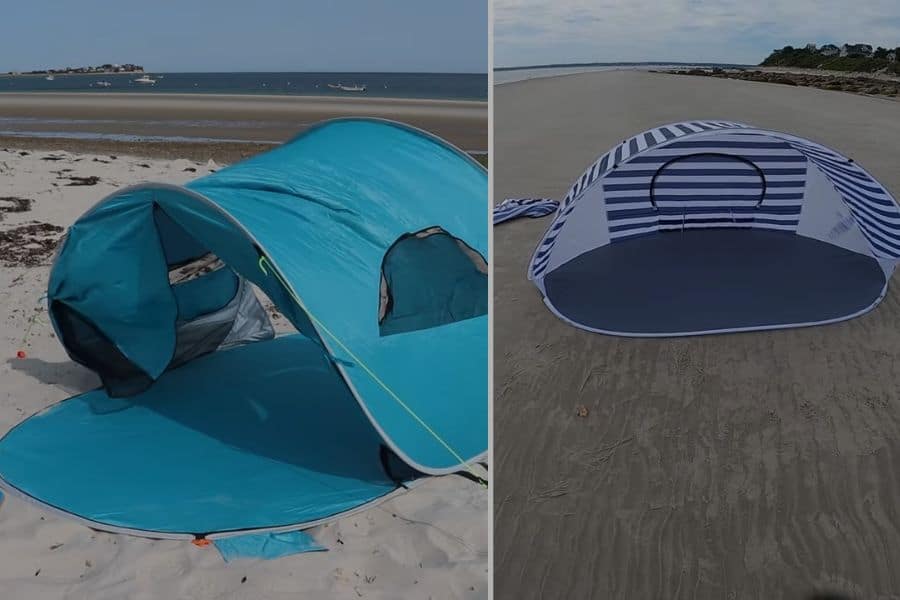
Another great thing about pop-up tents is their versatility. Whether you’re camping on the beach, deep in the woods, or at a designated campground, pop-up tents are a suitable option for the trip.
Pop-up tents can be placed on pretty much any terrain. The spring force keeps them erected, so you don’t have to work twice as hard to stake them out, especially when you’re dealing with tough ground.
Now, I’m not saying you shouldn’t stake your pop-up tent at all. Aside from the stuff you put inside, those stakes are what keep your tent from moving in the case of a breeze.
But unless it’s blowing like wild, you don’t have to stress too much about how well your tent is staked.
Disadvantages Of Pop Up Tents
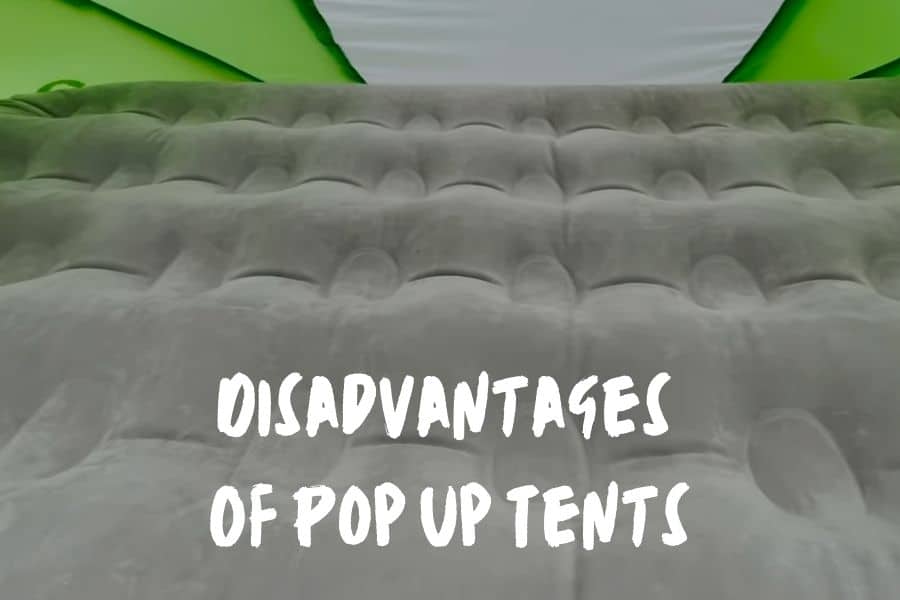
Unfortunately, pop-up tents aren’t without flaws. There are a few things that you should keep in mind before getting one.
Limited Size & Space
Camping tents come in numerous capacities, ranging from 1-to-20-person. But pop-up tents have quite a limited capacity range, with most free-standing models being in the 1-to-6-person range.
The spring force makes packing the tent down somewhat difficult. And the larger the tent, the stronger the force.
Imagine trying to pack down a 20-person pop-up tent. One bad step could cause the spring to unwind, potentially launching you in the air from all that pressure. I might be exaggerating, but you get my point.
Instant tents do typically come in larger sizes, mainly ranging between 6-and-12-person tents. But there are only a handful of models on the market in this size, so keep that in mind when considering buying a large tent.
Less Durable Than Regular Tents
The whole spring system pop-up tents use is pretty impressive, but it does come at a price. And I’m not talking about actual money, but the durability of such tents.
You see, the poles of packed pop-up tents are under constant tension. So during that time the tent is sitting in your garage, the tension builds up in those poles. And eventually, it will take a toll on their sturdiness.
That’s because pop-up tent poles are made of fiberglass, which is ideal for this use because it is light and flexible. However, this strain on the fiberglass can eventually lead to breakage.
Plus, the more you use the tent, the more the poles are at risk of snapping from damage.
Read More: Aluminum Vs. Fiberglass Tent Poles – Which Is Best?
Limited Weather Resistance
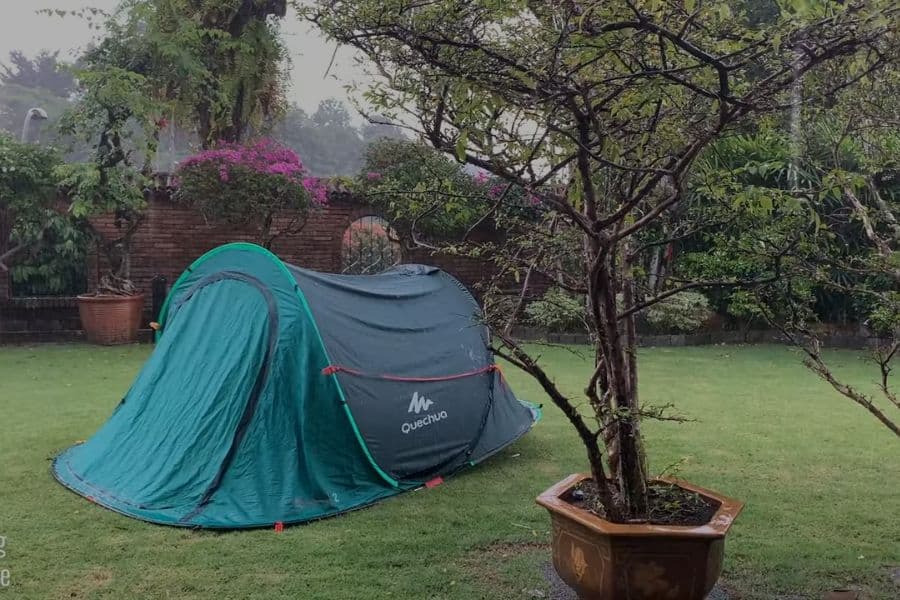
While pop-up tents are very versatile when it comes to location and terrain, the same can’t be said for their protection against weather elements.
You see, most pop-up tents are designed for camping in decent weather–like late spring or early fall with warm days and dry, mild nights.
That’s not to say they can’t handle a bit of bad weather, but they’re often not suitable for harsher elements.
When it comes to wind, free-standing pop-up tents are less stable compared to regular tents due to their flexible, thin-pole structure.
Of course, wind resistance depends on the model, but most pop-up tents aren’t suitable for use when it’s blowing above 25 mph.
Instant tents have a more rigid frame, but it’s their size that makes them less ideal for windy weather. Most instant tents are large and have straight walls, which can lead to those walls catching the wind like the sail on a boat.
Many pop-up and instant tents usually have short rain flies that only cover the roof, leaving doors and windows exposed.
This can be an issue if it starts raining, especially if it’s also windy, as you’ll need to use a tarp or something else to achieve better weather protection.
Single-Wall Pop Up Tents Are Less Breathable
To make things clear: not all pop-up tents are single-walled. In fact, a good portion of pop-up models is actually double-walled with a separate rain fly.
But single-walled tents are the ones I have a problem with.
Now, single-walled tents aren’t necessarily a bad thing. Many backpacking models use this design to save on weight.
However, when it comes to pop-up tents, they often lack other features that compensate for the single fabric use.
They don’t usually switch to a breathable material or position vent openings to compensate for the lack of airflow.
In reality, many single-walled pop-up tents are designed to fit the budget. Their versatility is something first-time campers may value over other things, but they are not always practical.
If it’s a lovely, dry night outside, the budget-friendly tent will work just fine for those campers..
But as soon as they camp in rainy weather, they will understand that the lack of ventilation and weather resistance is the reason why it was so affordable.
Regular Tents
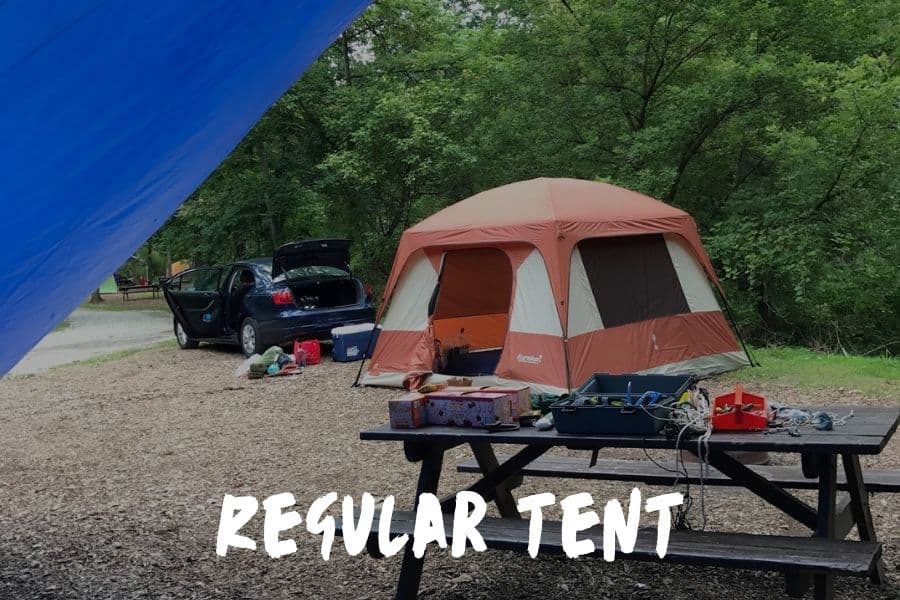
Unlike pop-up tents, regular tents come completely disassembled. Pitching them then requires putting the parts together in a specific order.
First, you need to lay out the tent body, assemble the poles, and attach them to the tent either through the pole sleeves or by attaching pole clips onto them.
Finally, if a tent has a separate fly, you put them on top of the construction and attach them to the poles as well.
Of course, these steps can differ depending on each tent model, but the premise of how to set up a regular tent is the same.
Types Of Regular Tents
There are tons of variations of regular tents, and they each offer different benefits. Here is a list of several different types of tents:
Dome Tents
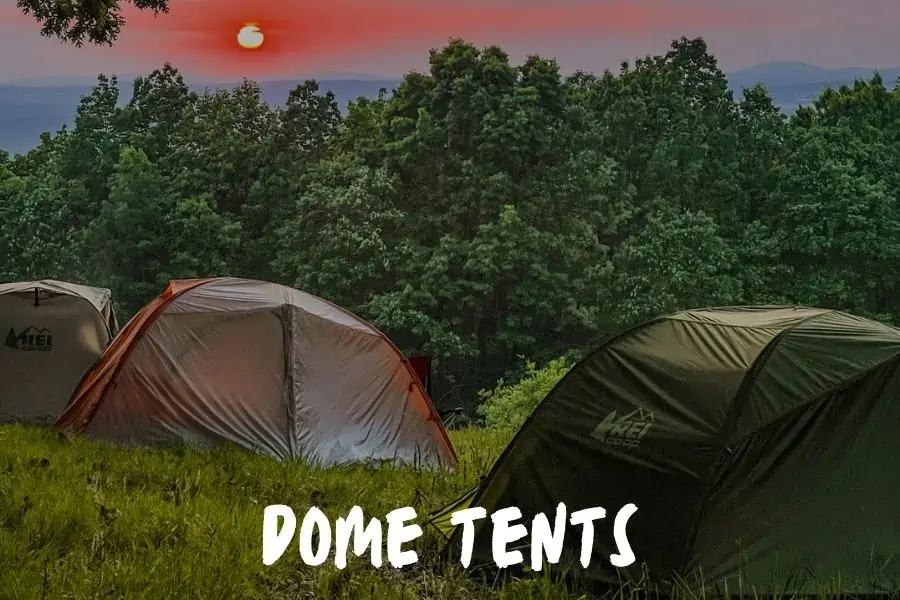
Dome tents get their name from their dome-shaped roofs, which are achieved by intercrossing two or more poles on the top of the tent.
Their unique, semi-oval construction is what creates their most helpful aspect: great weather protection.
Their dome shape plays the biggest role in that. The sloped sides prevent rain and snow from building up on the roof.
This way, rain or snowflakes just slide down onto the ground. The sloped sides also allow the wind to flow over and around the tent, keeping the tent stable.
Tunnel Tents
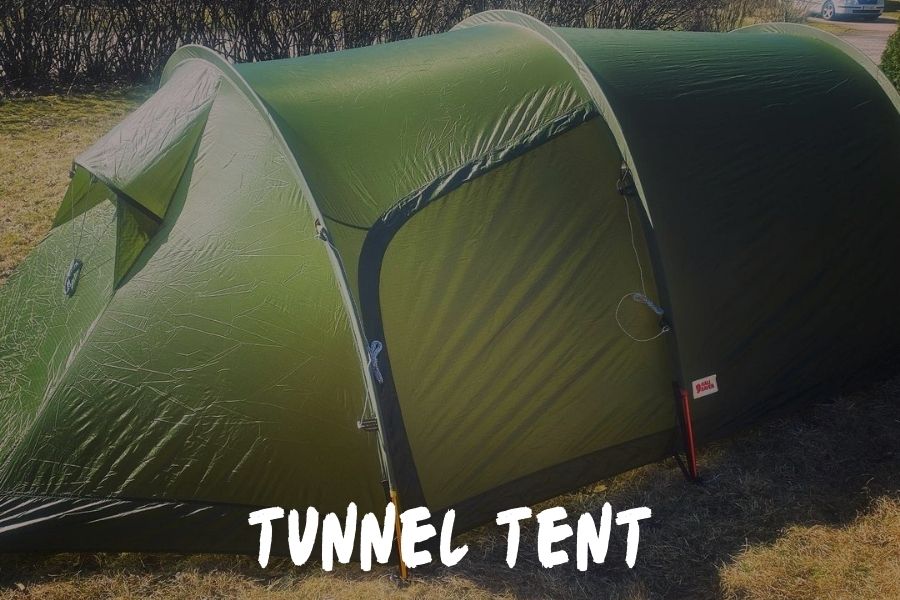
Tunnel tents are pretty similar in design to dome tents, they’re just longer and narrower and use more poles to hold the whole construction.
In terms of size, tunnel tents are usually much bigger than standard dome tents. In fact, they were designed for this purpose.
Tunnel tents typically have a capacity of six-plus people. Most of them also have their interiors divided into two or more sections for additional privacy and comfort.
Geodesic & Semi-Geodesic Tents
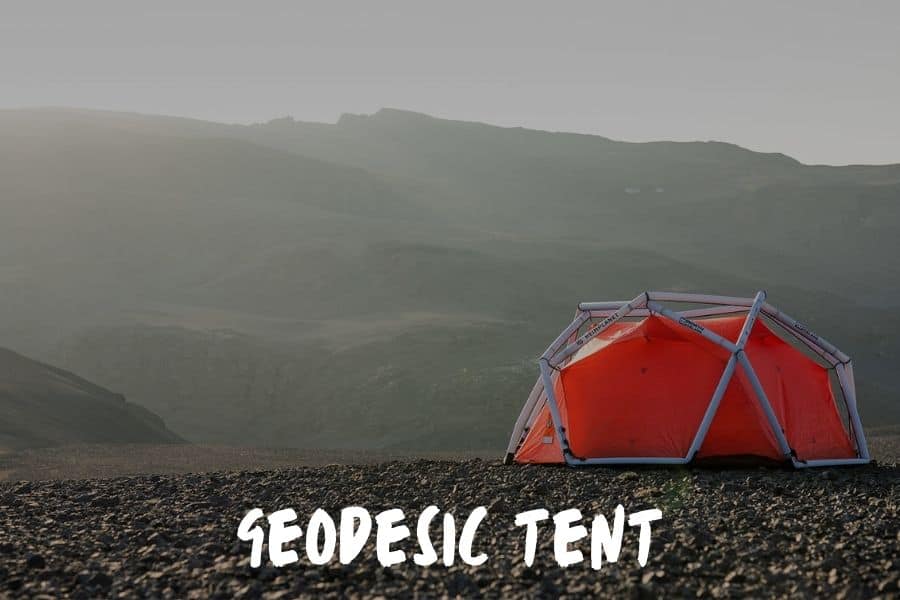
Geodesic tents have a semi-spherical structure achieved by intercrossing five or more pre-bent poles.
They are specifically designed for harsher weather conditions, and the multiple intersecting poles provide great stability.
Most geodesic model tents are made to withstand all weather conditions, and because of their stable frame, they are often free-standing (needing no stakes).
This makes geodesic tents very popular for mountaineering or any kind of camping on ground that may be difficult to stake into.
Much like fully geodesic tents, semi-geodesic tents are made by intercrossing several poles at an apex.
The main difference between the two is that semi-geodesic simply involves fewer poles, usually using three as opposed to five.
Semi-geodesic designs use fewer poles, so they are more lightweight than fully geodesic tents, which makes them popular for hiking and backpacking.
Advantages Of Regular Tents
While pop-up tents are convenient, standard tents provide several advantages for different reasons. Here are a few of the pros regular tents can provide:
Greater Variety In Size & Features
Regular tents come in all sizes, and their capacities can sometimes hold up to 20 people.
They also have a large range of features, from vestibules and awnings to room dividers and even built-in screen rooms.
So, no matter the size of your camping group or the length of your stay, you can surely find a suitable tent for your needs on the market.
Enhanced Durability & Stability
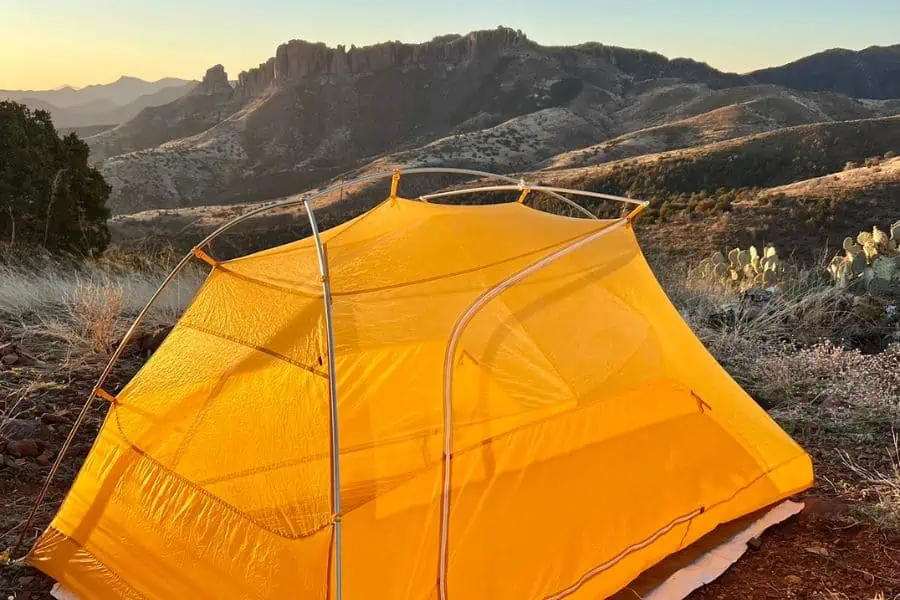
Of course, not all tents on the market are of the same quality. Still, most regular tents would win the durability battle against pop-up tents.
That’s mainly because your tent is fully disassembled when it is packed away in a storage bag and doesn’t put strain on the poles.
Regular tent poles have sections through which an elastic cord passes, which is why regular tents are more stable than pop-up tents.
This bending mechanism allows you to fold those sections without harming the poles. This provides less of an opportunity for you to bend or harm the poles. .
Even if regular tent poles are made of fiberglass, they’re still thicker and less likely to accidentally bend in storage.
Better Weather Protection
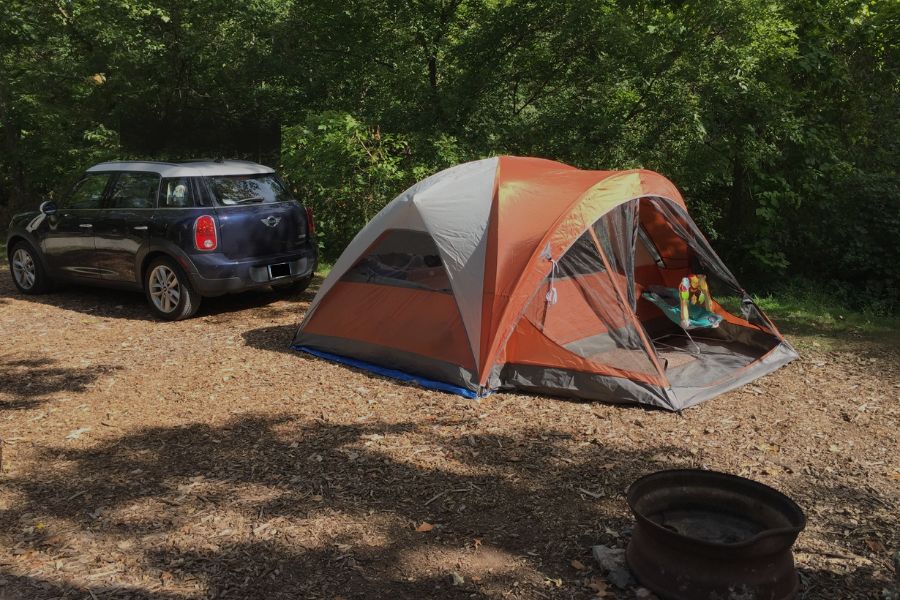
The exact degree of weather protection a tent offers depends on the model, but regular tents generally provide better weather protection.
Some regular tent types, like dome and geodesic, are designed to be practically weatherproof.
When it comes to wind protection, a tent’s durability depends on pole thickness and material, as well as the overall design of the tent.
All regular tents have thicker poles than their pop-up counterparts. Some may use other materials like steel or aluminum, as opposed to fiberglass, which are even better in protecting against wind.
Furthermore, regular tents typically have longer rain flies that reach the ground and keep doors and windows protected from rain.
They might also have a vestibule–a covered anteroom for extra storage and space–which also improves their weather protection.
Disadvantages Of Regular Tents
Of course, despite all the pros, even regular tents have a few disadvantages:
Longer Setup Time
First and foremost, regular tents take much longer to set up compared to pop-up tents.
Even for an experienced camper, pitching a tent can mean spending about 5-to-10 minutes just setting up.
In the case of larger tents, like family models, setup might be even longer.
Bulkier & Heavier
Regular tents, especially those larger ones, can be quite bulky and heavy when packed.
Things like vestibules and awnings can add weight to the packed tent. Plus, their poles are typically heavier than those with pop-up tents.
Harder For First-Time Campers
I won’t lie–pitching a tent was hard the first time.
With a pop-up tent, you essentially just take it out of the bag and your tent appears, ready to sleep in.
However, with regular tents, you have to study your manual closely to find out which part goes where.
Regular tents usually involve all kinds of grommets, guy lines, and poles you have to identify and place correctly.
If you don’t, you risk your tent falling on you in the middle of the night.
For a first-time camper, it is an intimidating task.
Factors To Consider When Choosing A Tent
Even with their apparent pros and cons, choosing between a pop-up and a regular tent can be hard.
But if you focus on certain requirements you need met, you can figure out which kind would suit you best.
Purpose & Frequency Of Use
Regular tents may be more durable compared to pop-up ones, but if you camp no more than once a year, will you really notice the difference?
Probably not, especially if you’re taking proper care of your camping gear.
So, for casual campers, choosing between the two types of tents should be determined by other factors. Purpose, for instance.
If you plan on hiking or backpacking every now and then, you might want to opt for a regular tent.
Nowadays, many brands make tents optimized for these activities, meaning they’re designed to be light and compact.
If you prefer beach camping, on the other hand, I would recommend choosing a good pop-up tent instead. Why?
They’re not dependent on staking to stay taut and upright, like regular tents, which can be tough to achieve when camping on loose soil such as sand.
Size & Occupancy Requirements
How many people do you plan on camping with? In the case of smaller groups, both types of tents offer suitable capacities.
Still, you should keep in mind that most pop-up tents don’t have vestibules, which are great for storing gear outside and giving you extra space.
This means that if you choose a pop-up tent over a regular one, it’s always best to go one size up to make sure there’s enough room for your stuff inside.
For larger groups, regular tents are generally better. They come in larger capacities and usually have more features to make your camping trip as comfortable as possible.
Weather Conditions
The weather you might experience during your camping trip also plays a role in choosing a suitable tent type.
Well, if you plan on camping during dry, warm months, then both types will work.
But when it comes to heavier precipitation and high winds, this is when pop-up tents don’t perform that great.
Budget & Cost-Effectiveness
Truth be told, both types of tents can range from budget-friendly to high-end, depending on the model.
Overall, pop-up tents are considered to be more affordable. It makes sense, given that they use low-cost materials like fiberglass and often have less fabric compared to regular tents.
If you’re on a budget, getting a pop-up tent can actually be more cost-effective.
Regular tents have a huge price range, with tents going from as little as $50 all the way to a few grand.
Setup Time & Ease Of Use
Pop-up tents, hands down, take the win in this category. They take less than a minute to set up, and pitching is no rocket science: simply unfold the tent and let the magic happen.
While most regular tent models are still extremely easy to set up, they still have a slight learning curve. At the very least, you will need to flip through the manual.
After a few tries, pitching a regular tent will probably go quickly and smoothly. Still, you’ll need about 5-to-10 minutes to get it pitched, depending on its size.
FAQs
Which Tent Is Better In Rain Or Harsh Conditions (Pop Up Or Regular)?
Regular tents are way better for bad weather compared to pop-up tents. They typically have a better waterproof rating, and they’re more stable in high winds compared to pop-up tents.
Are Pop Up Tents More Expensive Than Regular Tents?
That depends on the model, but in general, pop-up tents are more affordable than regular tents since they use less material.
Which Tent Is More Durable (Pop Up Or Regular)?
Again, it depends on the specific model. But given they use thin fiberglass poles, pop-up tents are typically less durable compared to regular ones.
How Long Does It Take To Pack Up A Pop Up Tent Compared To A Regular Tent?
Packing a pop-up tent is pretty simple and takes about a minute once you get the hang of it. On the other hand, doing the same with a regular tent can take about 5-to-10, depending on the number of pieces it includes.
Can Pop Up Tents Be Customized With Add-Ons & Accessories Like Regular Tents Can?
Pop-up tents don’t typically have many accessories available that can be purchased separately.
Aside from a footprint or replacement parts, you can’t really modify your pop-up tent the same way you can modify a regular one.
Can Pop Up Tents Be Set Up On Any Type Of Terrain Or Only On Specific Types Of Surfaces?
Thanks to the spring system that keeps the tent erected, pop-up tents are easy to set up on practically any terrain.
To Sum Things Up
There are many differences between pop-up and regular tents. They each offer different benefits for different situations and needs.
There is no straight answer for which type of tent is better.
Ultimately, it is up to you to determine what you need from a tent and which tent can meet those needs.

